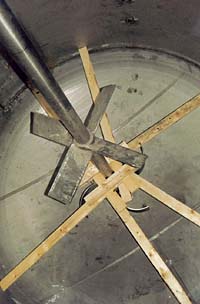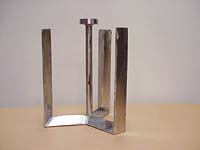Mixing it Up

Mixing History
In the beginning, when people wanted to mix something, not much was available. I imagine that sticks, boat oars or paddles were used to move products around in the mixing vessel. As mixing became more sophisticated, mechanical mixers were introduced. Turbine-type agitators were used and mixing technology began to advance as these mixers were studied and refined. Today, mixing equipment is quite sophisticated. Mixing systems now incorporate fully integrated controls, allowing the operator to control an entire process from a personal computer.
Defining Viscosity Ranges
For the purposes of this article, some general definitions of viscosity ranges should be established. Low viscosity will be defined as any liquid ranging from 1 to 10,000 centipoise (cps), medium viscosity from 10,000-30,000 cps, and high viscosity from 30,000 cps and up. Specific gravity will not play a part in this article, but should not be ignored as criteria for choosing a mixer.
Achieving High-Viscosity Mixing
Low-viscosity mixing is easily accomplished with conventional axial and radial turbine agitators. These agitators range in horsepower from 5 hp for production models, depending on blade diameter, speed, and product characteristics. Medium-viscosity mixing is also accomplished with the same type of mixers, but this viscosity range breaks the conventional rules of thumb for mixing. Blade diameters in relation to tank diameters begin to grow as the viscosity increases. The primary reason for this is an attempt to accomplish serial turnover. As viscosity increases, serial turnover becomes increasingly difficult. The further away from the blade you get, the less the product is inclined to move. As blade diameters increase, so does the required horsepower. As you move out of the medium-viscosity range and into the high-viscosity range, the problems of serial turnover cannot be solved with conventional turbine agitators. The blades will move product in close proximity to the blades, but any product below, in between and above the blades will not move. If dry or liquid raw materials are to be added or the product has to be heated or cooled, the problems are compounded. These problems sent mixer designers back to the drawing board.To solve the problems that occur in medium- and high-viscosity mixing, several blades and blade arrangements were developed.
Conventional anchor blade. One of the biggest problems with using conventional turbine-type blades in medium- and high-viscosity mixing is the lack of product movement at the vessel wall. The anchor blade was developed to solve this problem. This blade was designed to work in close proximity to the vessel wall, thus enhancing heat transfer.
Unfortunately, there are several inherent problems with anchor blades’ design. The primary problem is the lack of serial turnover. Anchor blades are designed with two or three vertical arms that are often triangular in shape. Typical blade-to-wall clearance for the anchor blade is 0.75-1 inch, which means that they typically just disturb the product at the vessel wall. To combat this problem, manufacturers have added all sorts of pumping blades, second shafts with screw augers, and gate blades to the design in an attempt to increase serial turnover. Of course, all of this tinkering causes the installation, operating expense and cost of the mixer itself to go up.
One blade design that will provide enhanced serial turnover, increase heat transfer at the vessel wall and assist in the incorporation of dry powders is the helical blade. Instead of straight vertical arms, this blade is designed with curved vertical arms that incorporate a twist. The typical blade-to-vessel wall clearance is the same as the anchor blade, though the helical blade has proven superior in serial turnover.
The blades work in the following fashion. The helical blade takes a section of the material theoretically as wide as the blade itself and displaces it down and in as the blade rotates clockwise, leaving the void behind the blade to be filled with new material. The basic flow pattern is serial turnover — down and in toward the center of the vessel and up the center shaft. Why is serial turnover so important? From the standpoint of hot-melt adhesives, transferring the heat at the vessel wall quickly and evenly throughout the batch is essential. Without serial turnover, the material at or near the vessel wall stays there and continues to get hotter. The closer you get to the center of the vessel, the cooler the product, especially in larger vessels. If the product has insulating properties, this can make heat-up times even longer. Serial turnover allows even heat distribution throughout a batch, thus decreasing batch time while increasing product quality.

Case Study
The following is a scenario that I have witnessed both in our pilot mixer and in the field. A formula for a filled hot-melt adhesive with a viscosity range of 75-100,000 cps calls for the base adhesives to be heated to 375ºF. During this heat-up time, the filler has to be added to raise the final viscosity to its maximum. The first challenge to this scenario involves product movement off the vessel wall for heat transfer. Too little movement will run the risk of either scorching the product with a high wall temperature or taking an exorbitant amount of time to achieve the desired temperature. This challenge is overcome by utilizing a blade design that is constantly moving the product away from the vessel wall and allowing new product to move in behind it. Heat can be added through the vessel wall at a faster rate, therefore decreasing heat-up time.
The second challenge is getting the filler to fully mix in to the batch. The lighter it is, the harder it is to mix in. Serial turnover solves this problem as well. Without the benefit of serial turnover, this scenario could become a nightmare for a chemist, plant manager and an operator.
Conclusion
Independent tests on medium- to high-viscosity products proved the helical blade to offer anywhere from five to 10 times higher heat transfer coefficients than conventional agitators. One test involved a hot-melt adhesive with a viscosity of approximately 30,000 cps, which borders between medium and high viscosity. In this test, the helical blade was tested against an axial turbine blade that the customer was currently using in production. The axial turbine provided an average heat transfer coefficient of 8. The helical blade provided an average heat transfer coefficient of 40. Heat-up times were significantly faster with the helical blade, indicating that serial turnover was the key to the results.
There are many ways and means to mix medium- and high-viscosity products. Depending on your application, there are a number of variables to consider when choosing the right mixer.
This article is based on a paper presented at the 2003 TAPPI PLACE Conference and Global Hot Melt Symposium, Aug. 3-7 in Orlando.
For more information:
For more information on mixing equipment, contact Michael Pearce, Sales Manager, Reynolds Industries Inc., 3601 Foothills Way, Fort Mill, SC 29708; phone 803-548-4301; fax 803-548-1365; e-mail mpe1001@hotmail.com.Looking for a reprint of this article?
From high-res PDFs to custom plaques, order your copy today!


